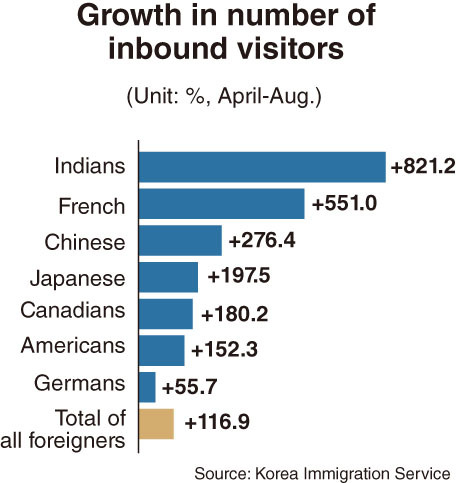[News Focus] Travel to Korea doubles from April low, but still depleted
August visits down 95% on-year, despite rising from 4 months earlier
By Kim Yon-sePublished : Nov. 12, 2020 - 15:53

SEJONG -- Earlier this year, the number of foreigners going through immigration dropped sharply in the wake of the novel coronavirus. But the figure has continued to rebound after touching the bottom in April.
According to the Korea Immigration Service, the number of foreign visitors to South Korea continued to drop -- from 1.32 million in January, 719,449 in February, 90,837 in March and 34,544 in April. The country’s first case of COVID-19 was reported on Jan. 20.
Among major visitors by nationality, the number of Chinese entering Korea declined from 509,852 to 4,685 over the first four months of the year. Japanese travelers fell from 208,054 to 495 and Americans from 74,812 to 6,830.
The monthly tally has started to recover slightly -- 37,324 in May, 42,367 in June, 67,817 in July and 74,927 in August, although this is still down heavily from 1.63 million in August 2019.

Compared to April, the number of Chinese inbound visitors surged 276 percent to 17,638 in August, followed by Japanese with a 197 percent growth to 1,473 and Americans with a 152 percent growth to 17,237.
During the January-August period, Chinese made up 28.9 percent of the total foreign inbound visitors, followed by Japanese with 18.2 percent, Americans with 8.4 percent, Taiwanese with 7.1 percent, and Vietnamese with 4.4 percent.
While some observers cast worries over the another phase of surge in the number of COVID-19 patients from the rebound in inbound visitors, some local retailers and the tourism industry are pinning hopes on a gradual recovery in terms of business operations in the coming months.
Nevertheless, the number of foreigners staying in the nation -- both short-term and long-term inbound visitors -- declined by 414,046 in only eight months due to a reduction in short-term visits.
The KIS data showed that the number of foreigners staying in the nation stood at 2.11 million as of August. This marked a 16.4 percent drop compared to eight months earlier in December 2019, when the figure reached 2.52 million.
The fall in the number of foreigners staying in the nation was especially marked among those with permission for stays of 90 days or less in Korea, which fell to 459,325 in August from 792,853 as of December 2019 to.
In contrast, the figure for longer-term visitors fell from 1.73 million to 1.65 million, a decline of 4.6 percent.
Though long-term visitors declined simultaneously, past data suggested that the tally could rapidly bounce back when the globe begins to recover from the pandemic.
After topping the 1 million mark in 2010 for the first time, the number of long-term foreign residents increased every year until the current decline.
The trend for short-term visitors was the same -- from less than 260,000 in 2010 to approaching 792,000 in 2019.
The average age of inbound travelers is estimated to have remained under 40.
Those in their 30s topped visiting age groups with 27.4 percent (577,970 among 2.11 million for both short- and long-term) as of August.
Those in their 20s made up 22.8 percent, followed by those in their 40s with 16.4 percent and those in their 50s at 14.7 percent. Those aged 60 or over and those under 20 accounted for 12.1 percent and 6.6 percent, respectively.
Among 1.19 million resident-registered foreigners – a figure that doesn’t include 460,000 people on F-4 visas -- 33.4 percent were residing in Gyeonggi Province, trailed by 21.4 percent in Seoul. Among 17 major areas across the nation, Sejong ranked bottom with portion of 0.4 percent.
By Kim Yon-se (kys@heraldcorp.com)



![[Exclusive] Korean military set to ban iPhones over 'security' concerns](http://res.heraldm.com/phpwas/restmb_idxmake.php?idx=644&simg=/content/image/2024/04/23/20240423050599_0.jpg&u=20240423183955)
![[AtoZ into Korean mind] Humor in Korea: Navigating the line between what's funny and not](http://res.heraldm.com/phpwas/restmb_idxmake.php?idx=644&simg=/content/image/2024/04/22/20240422050642_0.jpg&u=)



![[Graphic News] 77% of young Koreans still financially dependent](http://res.heraldm.com/phpwas/restmb_idxmake.php?idx=644&simg=/content/image/2024/04/22/20240422050762_0.gif&u=)






![[Exclusive] Korean military to ban iPhones over security issues](http://res.heraldm.com/phpwas/restmb_idxmake.php?idx=652&simg=/content/image/2024/04/23/20240423050599_0.jpg&u=20240423183955)



![[Today’s K-pop] Ateez confirms US tour details](http://res.heraldm.com/phpwas/restmb_idxmake.php?idx=642&simg=/content/image/2024/04/23/20240423050700_0.jpg&u=)